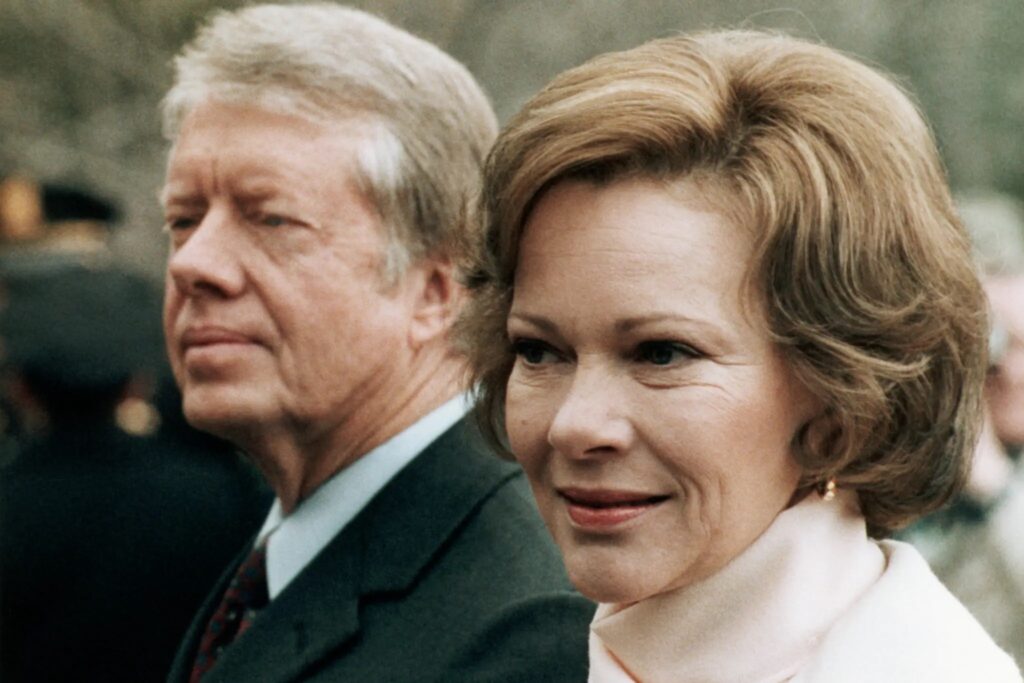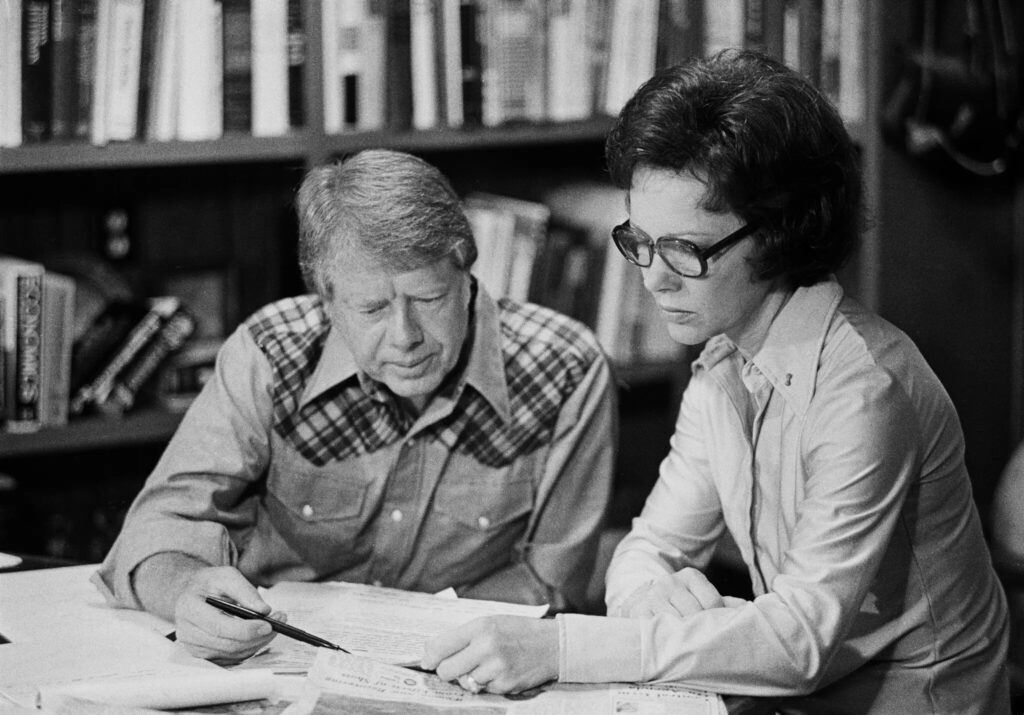
Rosalynn Carter died on November 19, 2023. She was 96. She was suffering from dementia. Jimmy Carter has been “dying” for a few years now, ever since he was diagnosed with brain cancer in 2015. He is now 99 years old. He’s now the oldest person who was ever president of the United States. He’s been on hospice care for most of this year. Rosalynn Carter was a national advocate for hospice, which is dedicated to letting people die at home, surrounded by their friends and family, and with dignity.
Jimmy Carter called her “almost an extension of myself.” “I was more a political partner than a political wife,” she explained in her 1984 memoir.
Behind her understated public demeanor, Rosalynn Carter was a formidable woman, wife, mother, spouse, and first lady. She was not Nancy Reagan gazing up in fierce possession and admiration at her husband. Rosalynn Carter carved out a distinct and significant role for herself in the White House years (1977-81) and Jimmy Carter had the good sense not to get in her way. She did not redecorate the White House or (like most other first ladies) order up a new set of formal china for state dinners. She was the first first lady to have her own suite of offices in the East Wing and a full staff dedicated to her work.
She was what might be called a “distaff feminist.” She insisted that her top White House aide be paid the same salary as her husband’s Chief of Staff. She attended Cabinet and National Security Council meetings and often took the first empty chair at the table, even when it was usually occupied by someone else, including the Vice President Walter Mondale. She spoke up at Cabinet meetings and sometimes directed the conversation. She was not afraid to speak quiet truth to power, whether the leader was her husband or Anwar Sadat or Menachem Begin or Ted Kennedy.
She was valedictorian in her class at Plains High School (class of ’44). She was in some respects a co-president. She was certainly one of Jimmy Carter’s chief advisers. The Carters had a formal working lunch once per week, where they discussed foreign and domestic policy. She was in many respects a shrewder student of politics than her husband, and a better judge of character. On her own, but on behalf of the administration, she undertook an extensive South American and Caribbean tour in 1977, for which she was criticized by the usual suspects. She was a quietly outspoken opponent of the death penalty. She supported the Equal Rights Amendment when it was politically costly to do so.

She wrote at least three books, two on mental health care, and her 1984 memoir, Lady from Plains; and she collaborated with Jimmy on a number of other books. Only Theodore Roosevelt wrote more books than the Carters, and he was Theodore Roosevelt.
She was an avid fly fisherman, not just the wife of one. She became the nation’s foremost advocate for the monarch butterfly and helped create the Rosalynn Carter Butterfly Trail, which represents a network of monarch-friendly public and private gardens throughout the hemisphere.
They left the White House in their 50s. In the half-century that has followed, they could be seen negotiating for the release of American captives in North Korea or hammering away with Habitat for Humanity on new houses for the poor. They transformed the definition of Presidential Library. The Carter Center in Atlanta (founded in 1982) is a schoolhouse for democracy and human rights, with projects in more than 80 countries worldwide, dedicated to human rights, fair elections, disease prevention, and the rule of law.
The Cliché
The cliché is that Jimmy Carter is one of the best former presidents in American history. I’ve done a fair amount of reading about the Carter years in the last few months. The more time passes, the better he looks, particularly in light of our current political dysfunction. He had extraordinary integrity. He was the first president to stand up to the military-industrial-hydrological complex. He canceled a large number of unnecessary water projects in the West and began to pull America back from its obsession with solving problems by pouring concrete.
Given all that has followed — Iran-Contra, Monica Lewinsky and Paula Jones, et al., Dick Cheney’s geopolitical darkness, “Iraq’s illusive weapons of mass destruction,” Michael Dukakis posing in an M-1 tank, John Kerry in hunting camo, George W. landing on the carrier under the sign “Mission Accomplished,” and the unsystematic nihilism of Donald Trump — I’ll take Jimmy Carter any old day.
Confession. I never really gave Jimmy Carter a chance back then. I was put off by his toothy earnestness and his smarm. A president should not be named Jimmy. And yet who ever thought of him as James Carter? He sure didn’t seem like a nuclear scientist. At first he seemed like a Southern hick to me, a different kind of accidental president — we were so traumatized by the Johnson-Nixon years that we needed some bland relief from all the national tension. Along comes a man who says he will never lie to us, an obviously decent man, a family man, a man with some embarrassing relatives, a true Christian. We must have needed it at the time, but I felt back then that the presidency had been compromised in a different way by the Carters. I know that was unfair, but that’s how much of America felt.
And then there was the Playboy interview in which he said he had occasionally lusted in his heart for women not his wife, and his account of being attacked by a “killer rabbit” while jogging. And personally managing the schedule of the White House tennis court. We will always remember him doing a White House chat while wearing a sweater, urging us to turn down the thermostat at home and lowering the national speed limit to 55 to conserve gasoline. The president as Mr. Rogers. And of course the agony of being president during the Iranian hostage crisis (November 4, 1979-January 20, 1981). I was in Washington, D.C., when the hostage rescue mission failed catastrophically on April 24, 1980 — a sign of America’s post-Vietnam impotence, and Jimmy Carter’s too. A pall of national powerlessness hung over Washington that week.
Jimmy and Rosalynn Carter did not have the sophistication or glamour of JFK and Jacqueline Kennedy; the charisma of Bill Clinton and the independent ambition of Hillary Clinton; the hauteur of Nancy Reagan or the geniality of her husband; the global perspective of Richard Nixon or the lapel-grabbing political mastery of LBJ, but she was more forceful and more interesting than either of their first ladies. She was one of the strongest first ladies in American history. She belongs in the same sentence with Eleanor Roosevelt, Hillary Clinton, and Michele Obama, and she was far more assertive in the public sphere than Laura Bush, Barbara Bush, Pat Nixon, or Melania Trump.
Katharine Q. Seelye’s obituary in the New York Times put it perfectly: “Reared in the same tiny patch of Georgia farmland, 150 miles south of Atlanta, they were similar in temperament and outlook. They shared a fierce work ethic, a drive for self-improvement and an earnest, even pious, demeanor. Their Christian faith was central to their lives. Both were frugal. Both could be stubborn.”
It’s possible to imagine LBJ’s Presidency without Lady Bird or Clinton’s without Hillary or Nixon’s without Pat, but it is not possible to imagine (or understand) Jimmy Carter’s political career without Rosalynn at the table.
They were partners in every sense of the word. Inevitably he will be gone soon, too.
It seems like a very long time ago when the Carters greeted Begin and Sadat at Camp David, on September 5, 1978, but their shared zeal for peace in the Mideast, and their unapologetic understanding that nothing can be resolved until the Palestinians have a viable state adjacent to Israel, is worth our deep admiration, especially in light of the slaughter of innocents we are witnessing both in and out of Israel.
